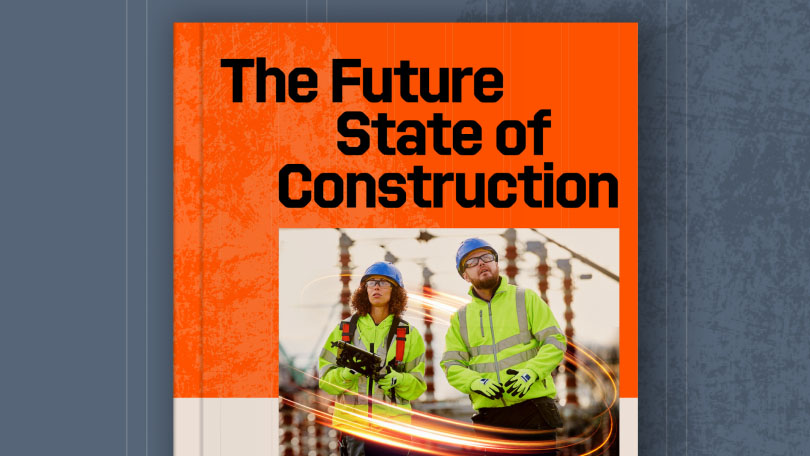— 7 min read
Understanding the 6 Phases of Project Management in Construction

Last Updated Jul 31, 2025

Tom Noctor
Senior Product Manager, International
16 articles
Having worked in construction for many years both on the ground as an electrician and in the design space in roles such as BIM Manager, I witnessed the highly inefficient operations of our industry and also the amount of waste generated from project delivery. I am a Digital Construction Technologies advocate @Procore Technologies, supporting and guiding the construction industry in adopting/utilising technology to deliver projects in a lean sustainable manner.
Last Updated Jul 31, 2025

Every construction project is unique, having different participants, variable conditions and one-off requirements. But across them all, you’ll find construction project phases are strikingly similar.
The construction phases of a project move on a linear timeline. Without them, you’d be left with no guiding structure for the project.
Table of contents
1. Project Design
The construction phases of a project’s life cycle begins with its design. Here, the owner builds the case for constructing the project. Sometimes, after all is considered, the owner might find the project is not workable.
Develop the business case.
Whether it’s a high-rise office building or a low-rise multifamily housing project, owners must always satisfy a business case for the project. In this part of the design phase, the owner envisions the property’s use and the financial incentives for that use.
Conduct a feasibility study.
The feasibility study either convinces the owner the project is possible, flags it as needing adjustments, or shows it as a no go. In this part of the design phase, the owner considers variables ranging from land use to construction costs while fine-tuning the best use. If the project is deemed possible, then it moves into the next phase.
Define the project scope.
In the scoping phase, the owner works closely with architects, engineers and sometimes even contractors to decide the project size and features. The goal is to match the finished project to its immediate use after construction and to accommodate additional uses as the project ages. At this phase, the design team renders all the drawings and specifications needed to build the project.
Learn about the future of the built environment - Read Procore's Future State of Construction report
Learn how contractors, subcontractors, and project teams can take advantage of new opportunities to boost efficiency and profitability over the next decade. Download the report to get your roadmap to the future state of construction.

2. Procurement
With the project plans completed, the owner moves the project to the next phase. In this second of the construction project phases, the goal is to assemble the team that will do the construction.
With the project plans completed, the owner moves the project to the next phase. In this second of the construction project phases, the goal is to assemble the team that will do the construction.
Select the procurement route.
A prime consideration is the procurement method. Until the last decade, owners almost always chose the design-tender-build delivery method. Today, more and more projects are opening up to design-build and integrated project delivery. These collaborative methods lead to lower costs and better project outcomes. The owner chooses the procurement method that will best fulfil the project’s goals.
Solicit tenders.
The owner often selects project participants by inviting contractors or construction managers to tender on the project. Sometimes the owner may already have a working relationship with particular contractors, like is often the case with corporate owners, so they will invite them to the project. Sometimes contractors submit hard tenders to win the project, while other times, the contractors and owners work together to design and price the project. In all cases, the owner is trying to achieve the best value for the money while rendering the project as close to their original intent as possible.
Award the contract.
Awarding contracts is the last part of this construction project phase. The owner must weigh multiple factors in selecting the builder. Price is a top consideration, but the builder’s track record, its ability to insure and bond for the project, and the builders’ experience with similar projects all figure into the decision.
3. Project Preconstruction
With contracts signed, the main contractor, or construction manager, gets to work on all details needed to start construction. First, they must round out the required help. Most MCs and CMs will come to the job with a group of subcontractors already known to them. However, speciality aspects to the project often require them to locate and partner with specialists. The MCs and CMs spend much time at this phase bringing people, materials and equipment together, and planning everything out.
Obtain permits.
Few localities exist where you don’t need permits for construction. Contractors get to work pulling permits for everything from utility work to building code requirements.
Survey the site.
Contractors consult site surveys to confirm their understanding of what already exists on the construction site. These surveys often find conditions that weren’t included in the contract documents. This is the first opportunity contractors have to record and begin managing the inevitable surprises inherent in any construction project.
Create a risk management plan.
Almost all contracts today require the contractor to have a formal risk management plan. The contractor must assess all the project risks and make plans for eliminating them, controlling them or insuring against them. Besides protecting the owner, these plans help the contractor foresee and avoid surprise costs arising from risks.
Develop a safety plan.
While safety is also a risk item on construction projects, contractors usually deal with it separately because safety risks are so far-reaching. They often involve life and death, so contractors want to make them a top priority.
Create the Work Breakdown Structure.
Contractors break construction projects into activities and tasks. Activities are the units of construction, like pouring the foundation. Tasks are the steps needed to pour the foundation. The work breakdown structure lists all the tasks needed for each activity. Many construction projects have thousands of activities, so the WBS creates a clear roadmap from project start to project end.
Lay out the project programme.
It’s project managers and programmers’ job to turn the WBS into a programme that work crews can follow. The programme reflects the longest time to project completion. It includes milestones so managers can assess how well the project is hitting its programme.
Set up a communications plan.
Construction contracts often require contractors to have a communications plan that meshes with the project comms plan. Here, the contractor specifies how required and time-sensitive communications should take place. They also include accountability controls so parties to the contract know their responsibilities for communicating project information.
4. Project Execution
The fourth phase is where all the earlier work gets validated, or not.
Hold a preconstruction meeting.
Contractors kick off the project with preconstruction meetings. During these meetings, all the parties review the project so they understand their roles and how they fit into the wider project.
Procure materials and equipment.
MCs and specialty contractors buy and order all the materials, parts and equipment needed for their portions of the work. They also set up their work crews and labour management plans.
Start building.
This part of the project execution phase is where the physical work begins. Contractors take virtual, or 2D plans, and turn them into 3D.
5. Project Control
Without controls, construction projects can get gravely sidetracked. There are too many moving parts and too many variables to operate without controls.
Track work status.
Once construction is underway, this is the most important of the construction project management phases. Without adequate tracking, it’s very easy to lose control of the activities. This is where many PMs rely on web-based construction management software because it’s always on and has the most recent project information.
Track activities against time objectives.
Each construction programme sets a time limit for each activity. Getting done early is sometimes as bad as getting done late, so project managers want to see how closely crews are hitting the programmed times.
Track and control quality.
Rework and variations fill the day without quality checks. Each task must meet the assigned quality. Otherwise, tasks coming after can also miss the quality mark.
Adjust the programme.
As project managers pour over the times and quality aspects of projects, they sometimes must adjust the programme to reflect the project’s latest trajectory.
Track the budget.
All parties working on the project have their own budgets to track. However, the MC or CM must also track the overall project budget. If the budget looks like it might start running in the red, the MC or CM must find the reason, and quickly.
6. Project Close Out
No matter its length, by the time people get to the last of the project’s construction phases, they are eager to get through the final troubling details.
Complete the snag list.
The snag list shows all the problems with the job that must get corrected before close out. Crews work on the portions of the snag list that match their specialities.
Commission systems and equipment.
For projects involving buildings, commissioning is the process of formally certifying that all the equipment and systems work properly.
Close out the budget.
Closing out the budget means that everybody can get paid the final monies owed to them. If the owner and MC have withheld retention, then this lump sum also comes due.
Planning For Success
It’s no coincidence the early construction project phases are more mired in detail than the later ones. Wise owners and contractors have figured out that an ounce of planning can cancel out many pounds of rework and mistakes. The construction project phases provide the framework for well-planned projects.
Categories:
Written by

Tom Noctor
Senior Product Manager, International | Procore Technologies
16 articles
Having worked in construction for many years both on the ground as an electrician and in the design space in roles such as BIM Manager, I witnessed the highly inefficient operations of our industry and also the amount of waste generated from project delivery. I am a Digital Construction Technologies advocate @Procore Technologies, supporting and guiding the construction industry in adopting/utilising technology to deliver projects in a lean sustainable manner.
View profileExplore more helpful resources

Construction Management Contracts: A Complete UK Guide
Managing construction contracts can lead to an extensive physical paper trail. Sharing contracts, getting signatures and managing timelines is difficult when teams and clients are scattered across job sites and...

Key Differences Between Contractors & Subcontractors
In UK commercial construction, main (or principal) contractors engage directly with project owners to deliver complete construction programmes, while subcontractors perform specific scopes of work under the main contractor’s management....

The Role of RFPs in UK Construction Projects
Requests for Proposals (RFPs) are a core document for construction procurement in the United Kingdom. Effective RFPs align expectations, establish clear evaluation criteria, and create accountability between clients and contractors....

Financial Management in Construction Projects
Effective financial management can make or break construction projects. Teams that master budgeting, cash flow and cost control are better positioned to deliver projects on time, within budget and with...
